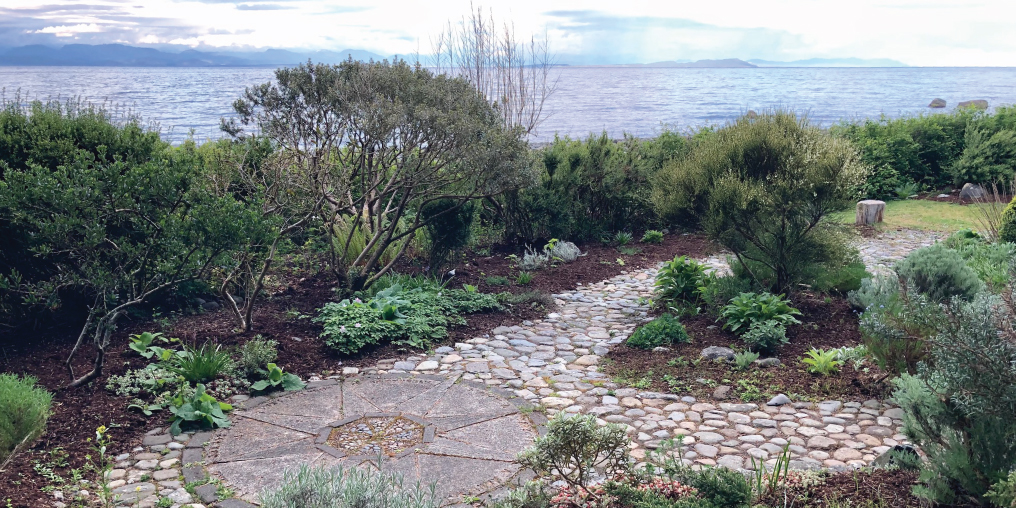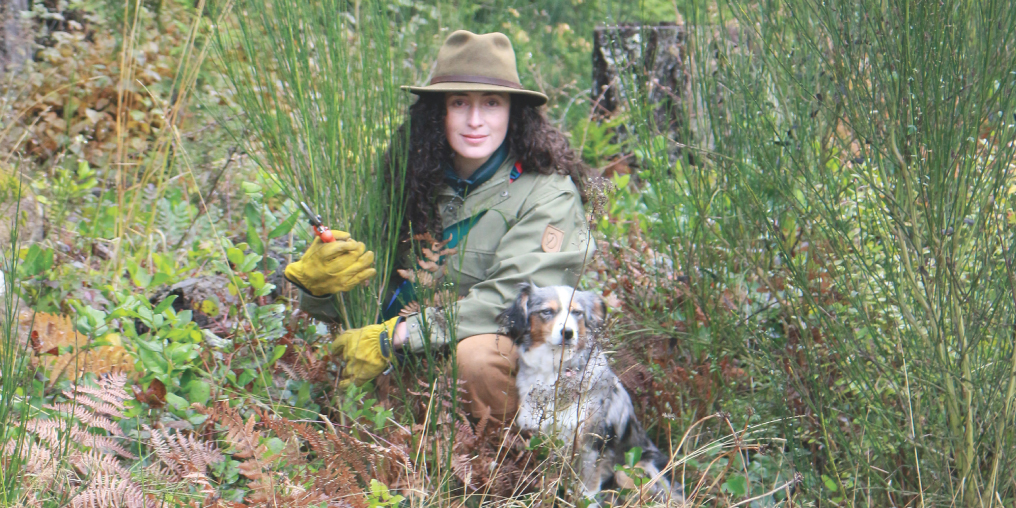A labyrinth has one single, visible path leading to the centre and out again. With no choices or decisions to make, one may simply follow the path, relax, meditate … the labyrinth also invites us to search the unknown while dancing lightly on our path.
—Aryana Rayne, Labyrinths of British Columbia, a Guide for Your Journey, p. 3
Reasons for walking a labyrinth are as diverse as each individual, and it’s possible to develop a personal relationship with labyrinths that evolves over time. Comox Valley residents Jerry and Janett Etzkorn have experienced profound insights and shifts in personal awareness while creating and walking labyrinths. Their deep practice and commitment to labyrinth walking informs their daily lives. For Jerry, it’s a way to nurture a connection to the Earth, while for Janett, it’s a connection to divinity and the greater mysteries. Jerry reveals, “Sometimes when I walk a labyrinth, I feel like I’m spiralling into the centre of our universe—falling toward a black hole, where the known and unknown exist in harmony.”

The Etzkorns spent 36 years as lighthouse keepers and raised their family “on the lights.” For 29 of those years, they lived at Carmanah Point Light Station on Vancouver Island’s West Coast Trail.
Their relationship with labyrinths originated in 1995, when Janett’s 17-year-old nephew died suddenly. Approximately one year later, after listening to an interview on the CBC program Tapestry, Janett was inspired to create a labyrinth as part of her grief process, an alternative to well-meaning folks who kept suggesting she “just get over it.” She began constructing a large labyrinth on the grounds of their Carmanah Lighthouse home, and completed it in 1997. The building process, then walking within the structure, supported the release of Janett’s grief energy, which ultimately led to a shift from sadness and loss to a connection with wonder.
From that early, isolated beginning, the Etzkorns have since connected with a worldwide community, meeting and learning in different sacred locations around the world. They share their passion for labyrinths with playfulness and joy.
Building a labyrinth
When building a personal labyrinth, be as elaborate as you want. For example, you can build altars to each of the four directions, place mementoes for ancestors and loved ones who have passed on, and/or fill the centre with prayers of remembrance and hope.
Would-be builders will discover that sacred geometry is at the heart of constructing any labyrinth. It’s all about replicating the “organizing force inherent in a snowflake, a bee’s honeycomb, a spiral seashell. It is the mathematical ratio in music and light … This is also part of the mysterious energy of the labyrinth form” (BC Labyrinths, p. 2).

Janett discovered the principle of sacred geometry as she was building her first Carmanah labyrinth. After walking her early attempts and realizing they didn’t yield the right energy, she did further research, revising her construction until she eventually found the right relationship among the stones.
Each labyrinth has a different energy, so it’s like entering a conversation, beginning a relationship. Before starting your walk, take a moment of stillness, perhaps blessing and thanking the labyrinth. You may want to make a request, ask a question, or state an intention. Jerry describes his practice of walking with the intention of sending healing energy to individuals having difficulties.
Whenever a labyrinth is created, the energy remains, even with a temporary labyrinth on a low-tide beach. The centre of one labyrinth is the centre of all labyrinths.
Janett notes that when she and Jerry share information with others about labyrinths, the reaction they often get is “amazing.” She smiles. “How perfect is that?”
There are three public labyrinths in the Comox Valley: Kitty Coleman Woodland Gardens, Innisfree Farm & Botanic Garden, and Anderton Therapeutic Gardens. Find labyrinths worldwide at labyrinthlocator.com.
How to walk a labyrinth
Respect the place.
Be aware of other people.
Look for whatever it is you’re seeking.
If you follow these guidelines, there is no wrong way to walk a labyrinth. Dance, run, walk backwards—however you’re called. You can exit using a different route or pace—but stay mindful. Jerry often goes barefoot; why not give that a try? If you can’t travel to (or safely walk) a physical labyrinth, try tracing your way through a finger labyrinth.





